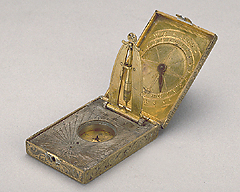
 |
| Catalogue |
 |
 Diptych Dial The inner side of the upper leaf has a 'wegweiser', inscribed 'SE', 'OR', 'ME', 'OC' and rotating arm. On the outer circle it is inscribed 1 to 12, 1 to 12 and on the external side '[star] weg [star] zaiger [star] [star] 15 [star] V [star] S [star] 79 [star]'. The inner part of the lower leaf has a silvered brass plate with compass viewing hole. The compass, at the centre of the leaf, is inscribed 'S', 'OR', 'M', 'OC' and magnetic deviation is indicated. Glass, ring and needle are missing. On the silvered leaf are engraved common hours, from 4 to 12 to 8, with a sun effigy engraved below the compass, and scrollwork decoration. The string, working as a gnomon but now missing, was tied to a small hole in the upper part of the folding plummet-holder. The outer part of the lower leaf is engraved with strapwork decoration, as are the sides of both leaves. The catch for closing the instrument is missing, and there are two catches for keeping the instrument open when in use. The instrument was presented by A.W. Franks in 1871 and is described in F. A. B. Ward, A Catalogue of European Scientific Instruments in the Department of Medieval and Later Antiquities of the British Museum (London, 1981), p. 43, no.104. Ilaria Meliconi |



